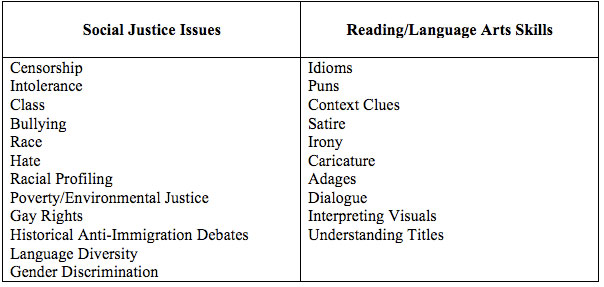Students enjoy editorial cartoons. Visual, engaging and often funny, they’re great learning tools. However, editorial cartoons can be challenging because they often require a lot of prior knowledge. These lessons provide strategies for using what students already know to analyze cartoons that may seem difficult to interpret.
In addition, these lessons will expand students’ knowledge of social justice issues. They can be used to supplement another lesson or readings, or they can stand alone.
Overarching Objectives
The lessons begin with a basic strategy for interpreting editorial cartoons. Each lesson helps build students’ background knowledge about a particular social justice issue. In addition, each lesson addresses at least one common English language arts skill. The objectives in every lesson combine these disciplines to challenge students and promote critical thinking skills. Here are some of the issues and skills addressed in the lessons:

Essential Questions
- How are editorial cartoons different from other kinds of art and media?
- Why do artists create editorial cartoons?
- How can images and text work together to deliver a message?
- How do I interpret an editorial cartoon?
- What are the important elements that many artists use in editorial cartoons?
Editorial Cartoon Lessons
Introduction This introductory lesson will help students learn strategies for analyzing editorial cartoons.
Racial Profiling This lesson will help students understand how a cartoon uses irony.
Censorship This lesson will help students understand how images can come together to make a statement in an editorial cartoon.
Poverty/Environmental Justice This lesson will help students analyze the visual composition of an editorial cartoon and understand how a cartoon uses satire.
Intolerance This lesson will help students see how artists can reveal their opinions about society and culture through a cartoon.
Gay Rights This lesson will help students understand how a cartoon uses idioms and puns.
Equal Opportunity This lesson will help students explore how editorial cartoons often use familiar adages or idioms in new ways to make a point about something.
A Historical Example of Immigration Debates This lesson will help students understand how a cartoon uses irony and caricature to make a political statement by examining a cartoon in its historical context.
Language Diversity This lesson will help students understand the importance of context in decoding an editorial cartoon and how a cartoon uses satire.
Bullying This lesson will help students understand how artists uses images to represent an idea.
Gender Discrimination This lesson will help students understand how a cartoon uses words and images to make a political statement.
Racism This lesson will help students understand how artists use titles to bring context to editorial cartoons.
Hate This lesson will help students understand the use of dialogue in editorial cartoons and question why one group might blindly hate another group.
A Conclusion This lesson will help students understand various strategies used in editorial cartoons to create an editorial cartoon that focuses on a social justice issue.